The Big Book of Pain: Torture & Punishment Through History (49 page)
Read The Big Book of Pain: Torture & Punishment Through History Online
Authors: Daniel Diehl
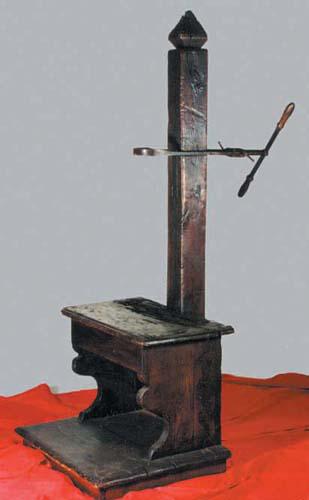
There are two basic types of the legendary garrotte. The first type is the Spanish garrotte, in which the screw draws back the iron collar, strangling the victim and killing him through the process of asphyxiation. The second type is the Catalonian garrotte which differs in that it has an iron point which penetrates and crushes the cervical vertebrae whilst at the same time forcing the entire neck forward and crushing the trachea against the fixed collar, thus killing by both asphyxiation and slow destruction of the spinal cord. The agony could, therefore, be prolonged according to the executioner’s whims. It must be remembered that the garrotte was a public spectacle and crowds could be unsatisfied by quick executions.
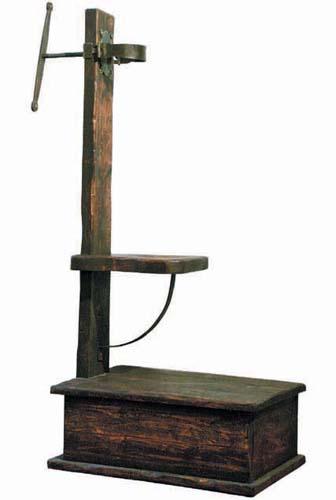
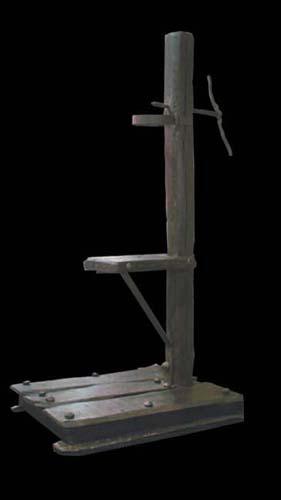
It is worth noting that there were variations in the functional mechanism at work in these devices. In some cases, the iron band around the throat was drawn back with the screw. In other cases, the iron spike at the back of the neck would be screwed forward. And in still other cases, the band would contract while the spike simultaneously bored forward.
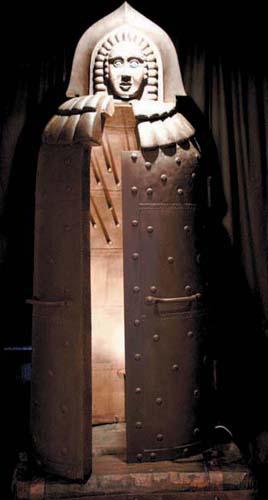

The history of torture records many devices that worked on the principle of anthropomorphic containers with double doors, fitted with spikes on the inside that pierced the victim contained within. The most famous example has always been the so-called ‘Iron Maiden of Nuremberg’, which was reportedly destroyed in the air raids of 1944.
It is difficult to separate legend from fact concerning this contraption because most published material is based on nineteenth-century research distorted by romanticism and fanciful popular tradition. The first reference to an execution with the Iron Maiden is on 14 August 1515, although the device had supposedly been in use for decades by then. On that day a coin forger was put inside the Maiden and the doors shut ‘slowly, so that the very sharp points pierced his arms, and his legs in several places, and his belly and his chest, and his bladder and the root of his member, and his eyes and his shoulders, and his buttocks, but not enough to kill him; and so he remained making great cry and lament
(gross Geschrey and Wehklag)
for two days, after which he died’. It is likely that the spikes were moveable among various sockets so as to be more or less lethal or mutilating according to the stature of the victim and the requirements of the sentence.
Investigative torture fell slowly into disuse in Germany with the passing of the eighteenth century, so that a tourist guide of 1784 speaks of ‘the Iron Maiden, that abominable work, of horror that goes back to the times of Frederick Barbarossa’, (an error of nearly four centuries, but one that showed the Maiden had already been relegated to the museum). Nevertheless, in 1788 sentences of drawing-and-quartering, breaking on the wheel and cutting off of tongues and hands were still being carried out in Nuremberg.
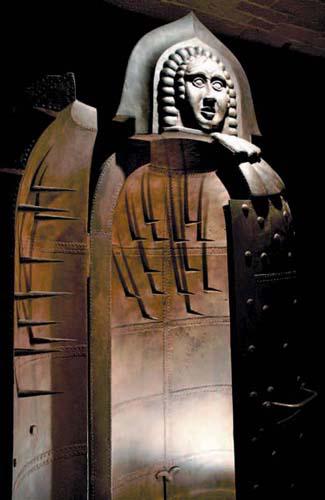
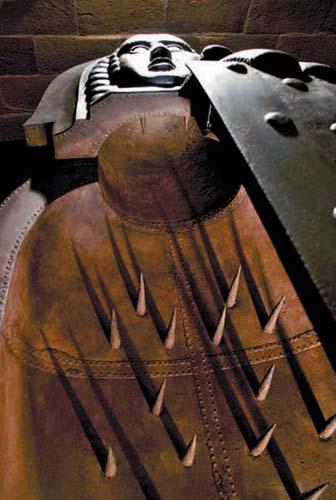
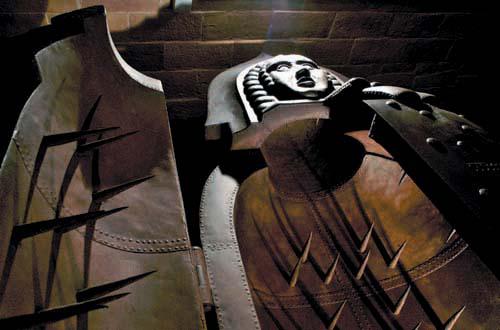

Appearing disturbingly like an over-sized baby’s cradle or bassinet, the Pass was a large, rectangular wooden box with rockers affixed to the bottom. The interior surfaces of the ‘cradle’ were set with sharpened iron spikes; when the victim had been stripped naked and lowered into the Pass, it would be ‘rocked’ violently back and forth. The results of which seem too self-evident to require further detailed description.
It is worth noting, however, the presence of the ‘spiked pillow’ within this device. Obviously this would not have afforded the victim any comfort whatsoever and may even be the product of a vicious and twisted sense of humour.

The Pillory is a form of torture similar to stocks. The victim’s head and/or limbs were locked in place, leaving them both helpless and defenceless. This device could be fixed solidly to any immovable object, or could be worn freely (as in the case of the Chinese Cangue), or perhaps tethered to a stationary point. In addition to the public humiliation the victim had to endure, they were commonly assaulted, molested and abused by members of the passing populace. Anyone sentenced to be pilloried was fair game as an open target to one and all unless loyal friends or family stepped forward to protect them.
Other books
No Strings Attached (Last Hope Ranch Book 1) by Amanda McIntyre
Possession by Ann Rule
Labor of Love by Moira Weigel
An Unlucky Moon by Carrie Ann Ryan
So Good: A Ribbon Ridge Novel (Love on the Vine Book 1) by Darcy Burke
The Last Supper by Willan, Philip
Soldier Up by Unknown
Glory by Alfred Coppel
To Everything a Season by Lauraine Snelling
Love Struck by P. M. Thomas